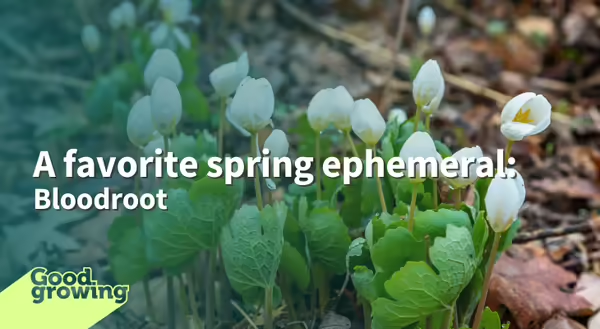
Bloodroot in the wild
Bloodroot is one of the earliest blooming plants in Illinois woodlands. A single, white bloom emerges wrapped in a single leaf from a rhizome. Blossoms do not produce nectar but rely on small bees and flies to transport pollen from flower to flower during a short bloom period. Once pollination has occurred, blooms mature into seed heads that contain more than a dozen small seeds. A unique feature of the bloodroot seed is the presence of an organ called an elaiosome. This fleshy structure is rich in fats and proteins that are attractive to ants. As ants harvest the elaiosome as a food source, they also transport the seeds to new environments thereby spreading the species.
The leaves of the bloodroot are multilobed and unfurl from around the flower stalk once pollination has occurred. The leaves continue to photosynthesize until the woodland overstory has emerged and shade out the woodland floor. The plants then disappear in the landscape, waiting until the next early spring months to reawaken them.
Bloodroot gets its common name from the red sap the plant exudes if cut. All parts of the plant exude a red-colored sap, but this is especially true of the tuberous roots. Indigenous groups including the Cherokee, Chippewa, Iroquois, Menominee, Meskwaki, Ojibwa, Potawatomi, and Winnebago used the sap as a dye.
Bloodroot at home
Bloodroot is a suitable plant for the home landscape where conditions provide morning sun, afternoon shade, and the soil is moist yet well-drained with high levels of organic matter. Bloodroot is tolerant of a wide range of soil pH, but like many woodland flowers, it prefers slightly acidic soils.
Plants or seeds should be obtained from reputable sources. Wild harvesting or collecting should not be done from wild populations.
For a naturalized appearance, plant Bloodroot with other native wildflowers such as Virginia Bluebells (Mertensia virginica), Spring Beauties (Claytonia virginica), Woodland Phlox (Phlox divaricata), and Wild Ginger (Asarum canadense).
Good Growing Fact of the Week: Bloodroot was used by indigenous people as a medicine to treat skin irritations and gastrointestinal ailments.
Sign up for our emails! Want to get notified when new Good Growing posts are available? SIGN ME UP
MEET THE AUTHOR
Emily Swihart is a Horticulture Educator with University of Illinois Extension, serving Henry, Mercer, Rock Island, and Stark counties since 2021. Emily provides horticulture programming with an emphasis on trees, native vegetation, and home landscape design.